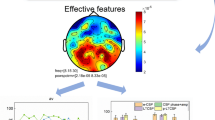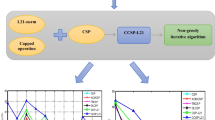Abstract
The common spatial patterns (CSP) is a classical approach to spatial filtering of electroencephalogram (EEG) used in brain-computer interfaces. The local temporal common spatial patterns (LTCSP) method is a temporal generalization of CSP. Both CSP and LTCSP, however, are only suitable for the two-class paradigm. In this paper, we address this limitation under the framework of Kullback–Leibler (KL) divergence. We show that CSP is equivalent to maximizing the symmetric KL divergence of two class-conditional probability density functions under the Gaussian assumption. This analysis establishes a probabilistic interpretation for CSP, as well as LTCSP. Based on the KL formulation, we propose a new multi-class extension to optimizing the spatio-temporal filters by maximizing the harmonic mean of all pairs of symmetric KL divergences between the filtered class-conditional densities. Experiments of classification of multiple EEG classes on the data sets of BCI competition show the effectiveness of the proposed methods.
Similar content being viewed by others
References
Arvaneh M, Guan C, Ang KK, Quek C (2011) Optimizing the channel selection and classification accuracy in EEG-based BCI. IEEE Trans Biomed Eng 58(6): 1865–1873
Bashashati A, Fatourechi M, Ward RK, Birch GE (2007) A survey of signal processing algorithms in brain-computer interfaces based on electrical brain signals. J Neural Eng 4(2): R32–R57
Bian W, Tao D (2008) Harmonic mean for subspace selection. In: Proceedings of IEEE 19th International Conference of Pattern Recognition
Blankertz B, Müller K-R, Krusienski DJ, Schalk G, Wolpaw JR, Schlögl A, Pfurtscheller G, Millán JR, Schröder M, Birbaumer N (2006) The BCI competition III: validating alternative approaches to actual BCI problems. IEEE Trans Neural Syst Rehabil Eng 14(2): 153–159
Blankertz B, Tomioka R, Lemm S, Kawanabe M, Müller K-R (2008) Optimizing spatial filters for robust EEG single-trial analysis. IEEE Signal Process Mag 25(1): 41–56
Boyd S, Vandenberghe L (2009) Convex optimization. Cambridge University Press, Cambridge
Brunner C, Naeem M, Leeb R, Graimann B, Pfurtscheller G (2007) Spatial filtering and selection of optimized components in four class motor imagery EEG data using independent components analysis. Pattern Recognit Lett 28(8): 957–964
Cleveland S (1979) Robust locally weighted regression and smoothing scatterplots. J Am Stat Assoc 74: 829–836
Cover TM, Thomas JA (1991) Elements of information theory. Wiley, New York
Dornhege G, Blankertz B, Curio G, Müller K-R (2004) Boosting bit rates in noninvasive EEG single-trial classifications by feature combination and multi-class paradigms. IEEE Trans Biomed Eng 51(6): 993–1002
Dornhege G, Krauledat M, Müller K-R, Blankertz B (2007) General signal processing and machine learning tools for BCI. In: Toward brain-computer interfacing. MIT Press, Cambridge, pp 207–233
Golub G, Loan van C (1996) Matrix computations. Johns Hopkins University Press, Baltimore
Gouy-Pailler C, Congedo M, Brunner C, Jutten C, Pfurtscheller G (2010) Nonstationary brain source separation for multiclass motor imagery. IEEE Trans Biomed Eng 57(2): 469–478
Grosse-Wentrup M, Buss M (2008) Multiclass common spatial patterns and information theoretic feature extraction. IEEE Trans Biomed Eng 55(8): 1991–2000
Lemm S, Blankertz B, Curio G, Müller K-R (2005) Spatio-spectral filters for improved classification of single trial EEG. IEEE Trans Biomed Eng 52(9): 1541–1548
Lotte F, Guan C (2011) Regularizing common spatial patterns to improve BCI designs: unified theory and new algorithms. IEEE Trans Biomed Eng 58(2): 355–362
Li Y, Gao X, Gao S (2004) Classification of single-trial electroencephalogram during finger movement. IEEE Trans Biomed Eng 51(6): 1019–1025
McFarland DJ, Anderson CW, Müller K-R, Schlögl A, Krusienski DJ (2006) BCI meeting 2005: workshop on BCI signal processing: feature extraction and translation. IEEE Trans Neural Syst Rehabil Eng 14(2): 135–138
Müller-Gerking J, Pfurtscheller G, Flyvbjerg H (1999) Designing optimal spatial filters for single-trial EEG classification in a movement task. Clin Neurophys 110(5): 787–798
Parra LC, Spence CD, Gerson AD, Sajda P (2005) Recipes for linear analysis of EEG. Neuroimage 28(2): 326–341
Ramoser H, Müller-Gerking J, Pfurtscheller G (2000) Optimal spatial filtering of single trial EEG during imagined hand movement. IEEE Trans Rehabil Eng 8(4): 441–446
Tao D, Li X, Wu X, Maybank SJ (2009) Geometric mean for subspace selection. IEEE Trans Pattern Anal Mach Intell 31(2): 260–274
Wang H, Tang Q, Zheng W (2012) L1-norm-based common spatial patterns. IEEE Trans Biomed Eng 59(3): 653–662
Wang H, Zheng W (2008) Local temporal common spatial patterns for robust single-trial EEG classification. IEEE Trans Neural Syst Rehabil Eng 16(2): 131–139
Webb AR (1999) Statistical pattern recognition. Oxford University Press, London
Wolpaw JR, Birbaumer N, McFarland DJ, Pfurtscheller G, Vaughan TM (2002) Brain-computer interfaces for communication and control. Clin Neurophys 113(6): 767–791
Author information
Authors and Affiliations
Corresponding author
Rights and permissions
About this article
Cite this article
Wang, H. Harmonic Mean of Kullback–Leibler Divergences for Optimizing Multi-Class EEG Spatio-Temporal Filters. Neural Process Lett 36, 161–171 (2012). https://doi.org/10.1007/s11063-012-9228-y
Published:
Issue Date:
DOI: https://doi.org/10.1007/s11063-012-9228-y




